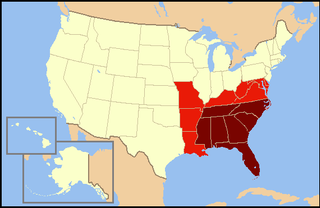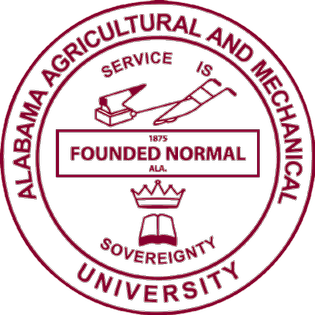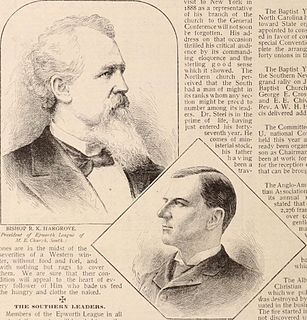
Tuskegee University is a private, historically black university (HBCU) located in Tuskegee, Alabama, United States. It was established by Lewis Adams and Booker T. Washington. The campus is designated as the Tuskegee Institute National Historic Site by the National Park Service and is the only one in the U.S. to have this designation. The university was home to scientist George Washington Carver and to World War II's Tuskegee Airmen.

The University of Alabama is a public research university in Tuscaloosa, Alabama. It is the flagship of the University of Alabama System. Established in 1820, the University of Alabama (UA) is the oldest and largest of the public universities in Alabama. The university offers programs of study in 13 academic divisions leading to bachelor's, master's, Education Specialist, and doctoral degrees. The only publicly supported law school in the state is at UA. Other academic programs unavailable elsewhere in Alabama include doctoral programs in anthropology, communication and information sciences, metallurgical engineering, music, Romance languages, and social work.

The National Sea Grant College Program is a program of the National Oceanic and Atmospheric Administration (NOAA) within the U.S. Department of Commerce. It is a national network of 33 Sea Grant Colleges and universities involved in scientific research, education, training, and extension projects geared toward the conservation and practical use of the coasts, Great Lakes, and other marine areas. The program is administered by the National Oceanic and Atmospheric Administration (NOAA) and is based in Silver Spring, Maryland. No sea rights have actually been granted, only money.

Troy University is a comprehensive public university that is located in Troy, Alabama, United States. It was founded on February 26, 1887 as Troy State Normal School within the Alabama State University System by an Act of the Alabama Legislature. It is the flagship university of the Troy University System. Troy University is regionally accredited by the Southern Association of Colleges and Schools Commission on Colleges (SACS) to award associate, baccalaureate, master's, education specialist, and doctoral degrees.

The Southeastern United States is broadly, the eastern portion of the Southern United States, and the southern portion of the Eastern United States. It comprises at least a core of states on the lower Atlantic seaboard and eastern Gulf Coast. Expansively, it includes everything south of the Mason-Dixon line, the Ohio River and the 36°30' parallel, and as far west as Arkansas and Louisiana. There is no official U.S. government definition of the region, though various agencies and departments use different definitions.

The University of Alabama in Huntsville is a state-supported, public, coeducational research university in Huntsville, Alabama, United States. The university is accredited by the Southern Association of Colleges and Schools to award baccalaureate, master's and doctoral degrees, and is organized in eight colleges: business administration, education, engineering, honors college, arts, humanities & social sciences, nursing, professional & continuing studies, science and graduate studies.

Alabama Agricultural and Mechanical University is a public, historically black, land-grant university located in Normal, a neighborhood of Huntsville, Alabama, United States. AAMU is a member-school of the Thurgood Marshall College Fund and has been accredited by the Southern Association of Colleges and Schools. Founded in the 1870s as a normal school, it took its present name in 1969. Alabama Agricultural and Mechanical University Historic District, also known as Normal Hill College Historic District, has 28 buildings and 4 structures listed in the United States National Register of Historic Places.

Centenary College of Louisiana is a private, four-year arts and sciences college located in Shreveport, Louisiana. The college is affiliated with the United Methodist Church. Founded in 1825, it is the oldest chartered liberal arts college west of the Mississippi River and is accredited by the Southern Association of Colleges and Schools (SACS).

Robert Kennon Hargrove (1829–1905) was an American bishop of the Methodist Episcopal Church, South, elected in 1882.
The United States Collegiate Athletic Association (USCAA) is a national organization for the intercollegiate athletic programs of 81 mostly small colleges, community colleges and junior colleges, across the United States. The USCAA holds 12 National Championship tournaments in 7 sports.

Marion Military Institute, the Military College of Alabama, is a public military junior college in Marion, Alabama. Founded in 1842, it is the official state military college of Alabama and the nation's oldest military junior college.

Uttar Pradesh Textile Technology Institute, Kanpur is a premier textile institute of North India. It offers professional degrees of bachelor's and master's of Technology, in branches of Textile Technology, Textile Chemistry and Man Made Fibre Technology, to students selected through a State Entrance Exam (UPSEE) conducted by Uttar Pradesh Technical University every year. It made a modest start in 1914.
The 1910 Alabama Crimson Tide football team represented the University of Alabama in the 1910 college football season. It was the Crimson Tide's 18th overall and 15th season as a member of the Southern Intercollegiate Athletic Association (SIAA). The team was led by head coach Guy Lowman, in his first year, and played their home games at the University of Alabama Quad in Tuscaloosa and the Birmingham Fairgrounds in Birmingham, Alabama. They finished the season with a record of four wins and four losses.

Summerfield, also known as Valley Creek, is an unincorporated community in Dallas County, Alabama. Summerfield has one historic district included on the National Register of Historic Places, the Summerfield District. Most of the community was annexed into Valley Grande following its incorporation as a city in 2003. Summerfield was the home of the Centenary Institute, a school operated by the Methodist Episcopal Church, South, from 1829 until the 1880s.
Richard H. Rivers was a nineteenth-century educator. He was president of Centenary College of Louisiana from 1849 to 1853 and subsequently president of La Grange College near Leighton, Alabama, an esteemed early Methodist institution. He also served as president of Centenary Institute in Summerfield, Alabama for a short time. Rivers was instrumental in relocating the fiscally troubled La Grange to nearby Florence in 1855, where it retained its Methodist affiliation and was known variously as Florence Wesleyan and Wesleyan College. Briefly prosperous, college failed during the Civil War after Rivers himself had departed. In the early 1870s, the property was turned over to the state of Alabama, and a normal school was established, known currently as the University of North Alabama.
The Centenary Gentlemen football team represented the Centenary College of Louisiana. The school's teams were known as the Gentlemen or 'Gents'. They have not competed in football since 1941. It last competed as a member of the Southern Intercollegiate Athletic Association.
The College of Engineering is one of the thirteen colleges at the University of Alabama. Located in Tuscaloosa, in the U.S. state of Alabama, the university began offering engineering classes in 1837. The university is the fourth-oldest engineering institution in the United States, after the Rensselaer Polytechnic Institute, Columbia University, and the University of Virginia.















